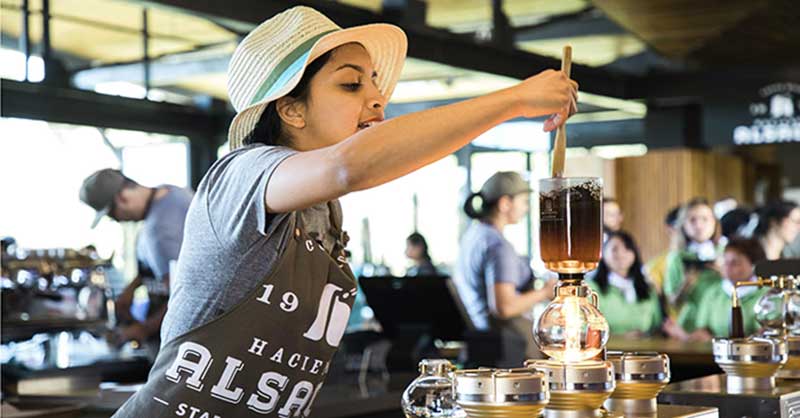
A peek at Starbucks coffee farm in Costa Rica.
Table of Contents
A peek at Starbucks coffee farm in Costa Rica.
- Shelli Galici
- 08-03-2018
- 29-07-2025
- 3213 views
- Coffee Shop, Featured Articles, How To's, Travel

The big coffee chain is getting bigger, and now venturing to a larger scale in the coffee business that they are now dominating in not just a coffee shop, but also in coffee production.
Starbucks had recently announced that they were opening their doors of one its coffee farms to give the public a chance to see how they source its beans.
About 45 minutes from the Costa Rican capital of San Jose sits a nearly 600-acre coffee farm called Hacienda Alsacia. Starbucks purchased it in 2013 and has used it as a global research and development facility.
The facility is being used as a testing and developing ground for the coffee beans where they test coffee trees for disease-resistant, and soil management techniques at the farm, this is also a ground for them to gain an understanding of the challenges that coffee farmers face when producing the crop.
For those coffee lovers who would like to see the coffee farm of Starbucks, but couldn’t take a trip here’s a peek at Starbucks coffee farm Hacienda Alsacia.
The Hacienda Alsacia

IMAGE courtesy of STARBUCKS
It was last year March 2017 when Starbucks announced their plan to develop a visitor center at Hacienda Alsacia. And on Wednesday, Starbucks said it would finally open the 46,000-square-foot center to the public.
For $25, coffee lovers can take a 90-minute guided tour, which includes coffee tastings, parking, and a Starbucks bandana.
Hacienda Alsacia is a prodigious 240 hectares or about 600 acres and was bought by Starbucks to serve as their learning ground on how to deal with rising production costs, weather changes and diseases like coffee rust, a fungus that can destroy an entire coffee crop.
According to Starbucks – about 97 percent of the world’s specialty coffee farms own less than 12 hectares of land, or about 30 acres, and have limited resources.
Hacienda Alsacia gives Starbucks a chance to create best practices for growing coffee and share that knowledge. CEO Kevin Johnson said that this is in the company’s best interest because it needs to ensure the future supply of quality coffee.

IMAGE courtesy of STARBUCKS
When Starbucks first purchased the land in Costa Rica, it was in bad shape and tilling the land was not easy because the soil is not fertile for coffee crops to grow. Though the company has funds to revitalize the land, they chose not to, instead, they hired someone to help them renovate the land to make it into a farm.
Starbucks hired Victor Trejos to manage the farm and renovate it with the same approach to investment and planning that a traditional farmer would be able to do.
“I can show them how we have been doing things,” Trejos said in a statement last year. “How we have been planting, how we fertilize, soil tests … And how they can do the same.”

IMAGE courtesy of STARBUCKS
What’s Inside the Farm
Hacienda Alsacia is home to a number of agronomists, specialists that research the best ways to produce and use plants.
At the farm, Starbucks researches and develops hybrid trees that are bred to be resistant to diseases like the coffee rust fungus. The company grows tree seedlings on location that it can donate to farms that have had their harvests ruined by pests or diseases.
Starbucks has already donated 30 million rust-resistant coffee trees and plans to distribute 100 million by 2025.

IMAGE courtesy of STARBUCKS
Those that visit Hacienda Alsacia will get a chance to see how Starbucks sources its coffee from the seed all the way to the cup.
“This visitor center allows us to create a connection between the people that grow the coffee, the role our farm plays in helping to ensure their economic stability, and the stores that roast and brew it for our customers every day,” said Cliff Burrows, group president of Siren Retail at Starbucks, when plans for the visitor center were first announced.

IMAGE courtesy of STARBUCKS
It’s a 90 minutes tour of the farm, and you will surely enjoy and learn more about coffee. The tour includes a look at greenhouse nurseries, coffee fields, the wet mill, the drying patio and ends at a Starbucks cafe.
The Hacienda Alsacia is an extension of Starbucks’ premium retail experiences, like its Roasteries and Reserve Bars. Executive Chairman Howard Schultz stepped down from his post as CEO of Starbucks to focus on creating destinations for coffee consumers.

IMAGE courtesy of STARBUCKS
Quick Fact: At Hacienda Alsacia, Starbucks partners (employees) take visitors on a guided tour, showing the coffee seed “journey” from the nursery, to the coffee fields, wet mill, drying patio and coffee bodega. Visitors will also see the innovation green house where Carlos Mario’s team’s hybrid tree research is on display. The tour wraps with a fully functioning café where you can enjoy the view overlooking the farm with a freshly roasted and brewed cup of Hacienda Alsacia coffee. Also available is an assortment of locally prepared morning and lunch food items. – STARBUCKS
Of course, at the cafe, you have the pleasure to taste the coffee you have been learning all day and take in views of the farm.

IMAGE courtesy of STARBUCKS






















